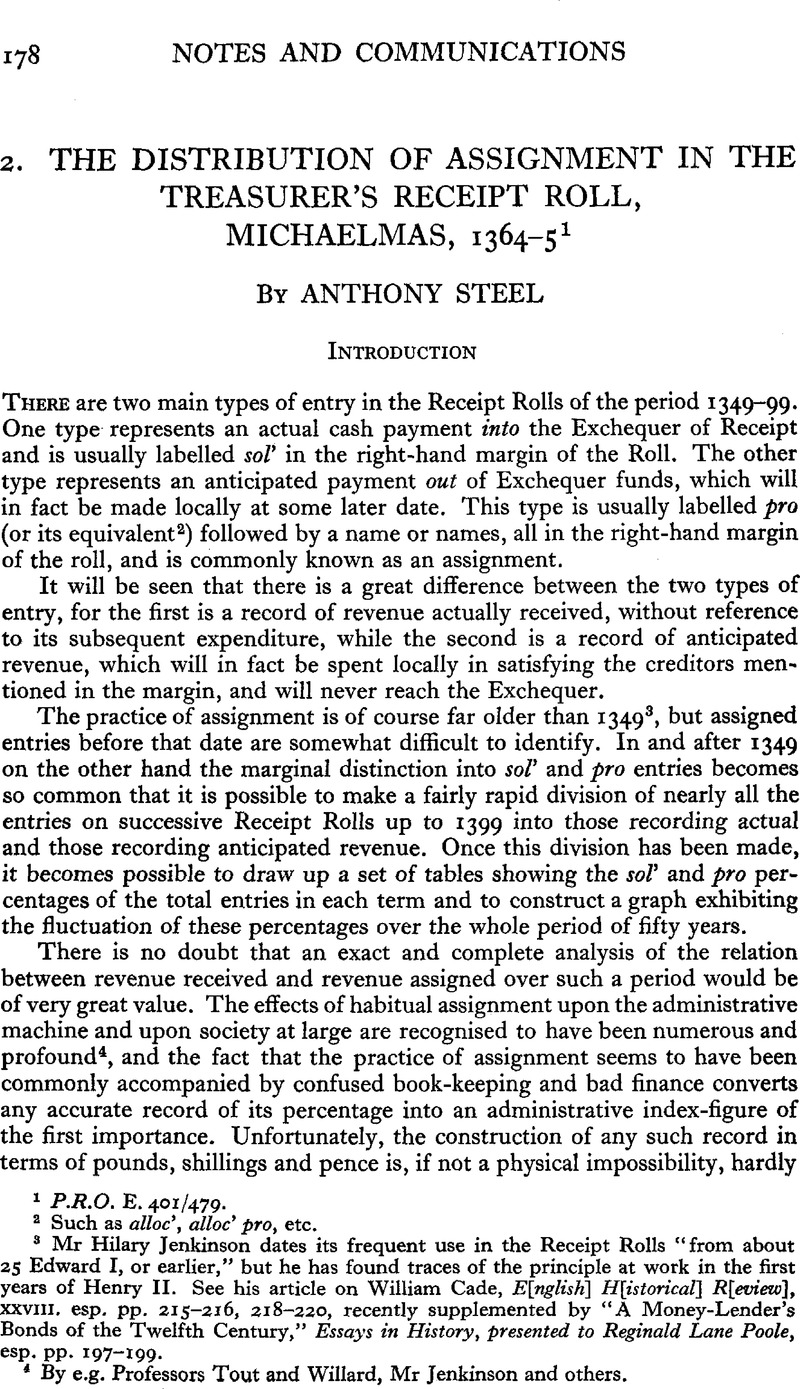No CrossRef data available.
Published online by Cambridge University Press: 20 December 2011

page 178 note 2 Such as alloc', alloc' pro, etc.
page 178 note 3 Mr Hilary Jenkinson dates its frequent use in the Receipt Rolls “from about 25 Edward I, or earlier,” but he has found traces of the principle at work in the first years of Henry II. See his article on William Cade, E[nglish] Historical] R[evieie], XXVIII. esp. pp. 215–216, 218–220, recently supplemented by “A Money-Lender's Bonds of the Twelfth Century,” Essays in History, presented to Reginald Lane Poole, esp. pp. 197–199.
page 178 note 4 By e.g. Professors Tout and Willard, Mr Jenkinson and others.
page 179 note 1 Professor Willard's article in E.H.R. XLII. 12–19, demonstrates the degree of labour necessary to get satisfactory results for two years only, prior to 1349.
page 179 note 2 This roll was selected more or less at random from those in which sol' and pro were both well represented.
page 179 note 3 Such entries are common throughout the greater part of the whole period. Their existence raises a fresh problem, which has not yet been solved: it had previously been assumed that one entry on the Receipt Roll represented one tally—see Hilary Jenkinson, “Medieval Tallies, Public and Private,” Archaeologia, LXXIV. p. 298—but with these entries it is difficult to see how that could be the case. In Table A their sol' element is reproduced separately, bringing the sol' total up to 302.
page 179 note 4 These groups are merely those suggested by the contents of this roll, not a standard arrangement.
page 179 note 5 Ramsay, Revenues, II. 81, gives “Issues of the Great Seal” as an alternative heading. “Hanaper” = “hamper,” or “a receptacle for loose records.” See Hubert Hall, Antiquities of the Exchequer, p. 52, and the illustration on p. 53.
page 180 note 1 Sir James Ramsay, Revenues of the Kings of England, II. Table I, opp. p. 292, adopts the total given at the end of the Roll (£37,315. 15s. 7d.) as the correct sum total for the term. It will be seen my total is £136. $s. 6£d. in excess of this: there are mistakes in the daily totals on 16 days which account for two-thirds of the difference. The remaining third may be my error but I cannot trace it. Cf. Prof. Tout's and Dr Dorothy M. Broome's difficulties with fourteenth-century arithmetic in E.H.R. XXXIX. 404–419.
page 181 note 1 See Prof. N. S. B. Gras, Early English Customs System, Part I. ch. II, in general.
page 181 note 2 These are, of course, taxes on movables and should strictly appear under a separate head. But their insignificance in this term, together with the fact that such taxes, as well as the taxes on trade, were called “subsidia,” provide an excuse for their insertion here.
page 181 note 3 This is the subsidium pannorum venalium, “really an excise collected with aulnage” (the fee for measuring cloth). Gras, op. cit. 78 n.
page 181 note 4 A fusion of that part of the “new” custom of 1303 which had related to cloth with the cloth custom of 1347. Gras, op. cit. pp. 75–6.
page 181 note 5 “De deb' plur'” is equally common and has been included under this head. Miss Mabel H. Mills extends “de plur' deb'” as “de pluribus debitis” and “de deb' plur'” as “de debitis plurium” for the period prior to 1340, the first referring to the debts of the payer, and the second to the debts collected by the payer. I am not sure that this distinction will hold for the period 1349–99.
page 182 note 1 See Professor Willard's “An Early Exchequer Tally,” Bulletin of the John Rylands Library, VII. no. 2, for an account of this process.
page 183 note 1 See Hilary Jenkinson, “Medieval Tallies, Public and Private,” Archaeologia, LXXIV. 299 n. But many more types of entry than the fictitious loan and the prestitum restitutum were without the dot.
page 183 note 2 Philip “the Bold,” youngest son of John, captured with him at Poitiers, received the duchy of Burgundy on the death of Philip de Rouvres 1361, married Margaret of Flanders, 1369. Tout, Political Hist, of England, 1216–1377, pp. 392, 400, 410.
page 183 note 3 Ramsay, Revenues, II. 232–3, states that ransom payments “would not swell the Pell Receipts. They would be stowed away in some treasury, probably at the Tower.” As a matter of fact King John's ransom appears repeatedly on the Receipt Roll and is included in the totals, though tallies are not struck for it. It is the same with the ransoms of Burgundy and Scotland. Cf. Dr Dorothy M. Broome's “Ransom of John II,” Camden Miscellany, XIV.
page 184 note 1 Recognised by Ramsay, Revenues, II. 243.
page 185 note 1 In the English Historical Review.